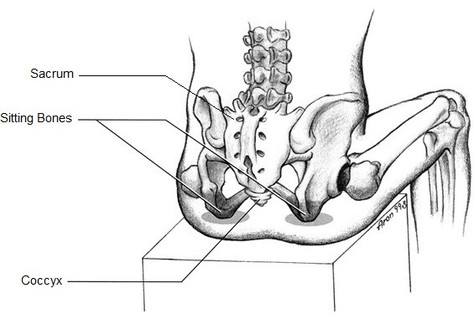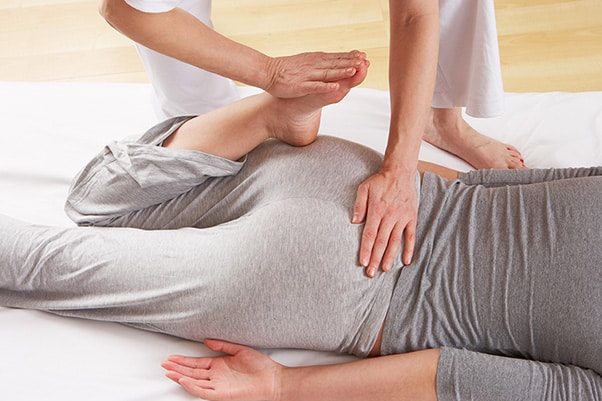Neuromuscular Massage Therapy (NMT), a client’s perspective. Bronwyn had just moved to Boulder, was looking for a massage therapist and one of the first things she mentioned at our session, was that she wanted a therapist who knew about neuromuscular therapy.

Each person may have a different reason to seek this type of therapy, however in Bronwyn’s case, she had recently had a treatment at the Sonnenalp Hotel in Vail, where the therapist specialized in Neuromuscular therapy. This treatment helped her low back pain and at the time, wrist issues. No stranger to massage therapy, Bronwyn knew this type of treatment was successful and hoped finding a new massage therapist locally, would assist with other aches and pains.
My lower back pain (& glute pain) is out of control!
Lower back pain encompasses many problem areas. In Bronwyn’s case she was experiencing tremendous pain in her sit bones and SI joints – which she referred to as glute trouble. It’s important to determine, if possible, the specific area causing pain and in her case we were able to work on those areas with neuromuscular massage therapy and provide substantial relief.

Figure A: Sitting view of lower back skeletal system
More detail
There’s much to discuss when it comes to lower back pain, so let’s discuss Bronwyn’s Sit Bones & SI Joint issues specifically.
Sit Bones – the common name for the ischial tuberosity, are formed by the connection of the sacrum and the right and left iliac bones. Many people assume their pain is coming from their sit bones (think about the pain you feel when sitting at your desk, or in a Yoga class), however you want to be sure the pain is actually your sit bones and not coming from the gluteal muscles. By checking for trigger points in gluteus maximus, medius and minimus we can better determine the area the pain is truly coming from. Knowing where the trigger point and pain is coming from will give us better results from the neuromuscular therapy.
SI Joints or sacroiliac joints are a very common area that can cause lower back, hip and leg pain. The SI joint (there are two), are formed by the connection of the sacrum and the right and left iliac bones, connecting the spine to the pelvis. The sacrum and the iliac bones are held together by a collection of strong ligaments. Most of the motion in the pelvis occurs either at the hips or the lumbar spine, relatively little motion occurs at the SI joints. The SI joints support the entire weight of the upper body when we stand upright, which can place a large amount of stress across them.
Not every massage place or person I researched knew about neuromuscular massage but I really wanted this type of therapy. – Bronwyn H.
What exacerbates these issues?
In her day to day life, Bronwyn sits for a living and often has long trips in both cars and airplanes, finding it incredibly difficult to look forward to these activities due to the amount of discomfort she experienced.

When a client comes in for treatment and points to their lower back as an issue, they may point to many different areas as the cause of their pain. Given there is very little muscle in the SI joint area, it can make trying to find the cause more challenging. Working surrounding soft tissue (glutes, hip area & piriformis) can yield good results.
In the many sessions we worked on her SI Joint and Sits bone pain, I targeted her lower back area including the top of her iliac crest (near the hip) and focused on stretching and working the glutes and hamstring muscles. For Bronwyn, this wasn’t a ‘relaxing’ massage, but in her words was “good pain”. Following treatments, she was able to gain a greater range of motion as well as a significant reduction in pain. Long term, as a regular client, she needed treatment in these areas less frequently.
Please note: If pain persists, see your doctor. There are several orthopedic tests you could ask your doctor to try as a way to diagnose for a particular issue.
What is Neuromuscular Massage?
Neuromuscular Massage is a specialized deep tissue massage where static pressure is applied to muscles and connective tissue to relieve pain.

This type of massage differs from deep tissue because it is static pressure on a specific muscle or muscle group for a sustained amount of time, rather than generally providing a deeper level of massage over the whole body. Neuromuscular massage assists and speeds the body’s natural ability to heal.
Example:
With deep tissue and Sits bone pain I may generally massage at a deep level, your glute and hamstring area, however with neuromuscular therapy, I will focus and work directly on specific ‘points’ in the lower back area that brings the most sensation so that I can then work those points with a combination of pressure, stretching and point work.
Benefits of Neuromuscular Massage:
NMT is ideal for those clients with chronic pain. Results can reduce longstanding conditions.
- Releases Chronic pain/tension patterns
- Breaks up scar tissue
- Decrease Pain
- Improve Chronic posture dysfunction
- Improve the function of body’s connective tissue
- Speeds the body’s natural ability to heal and recover from injuries. For example: work, sports and general issues.
Who needs Neuromuscular Massage?
You be the judge! Everyone should try this type of therapy if you are seeking relief from:
- Neck pain
- Low back pain
- Shoulder pain
- Instances of Limited Range of Motion
- Tightness/Tension patterns in the body
- Chronic Posture Dysfunction
Book your treatment today online or call to schedule an appointment.


